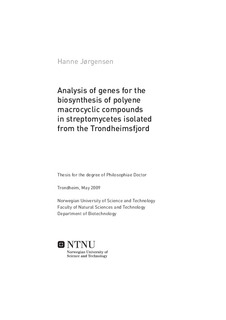| dc.contributor.author | Jørgensen, Hanne | nb_NO |
| dc.date.accessioned | 2014-12-19T13:14:13Z | |
| dc.date.available | 2014-12-19T13:14:13Z | |
| dc.date.created | 2009-06-12 | nb_NO |
| dc.date.issued | 2009 | nb_NO |
| dc.identifier | 223469 | nb_NO |
| dc.identifier.isbn | 978-82-471-1550-3 (printed ver.) | nb_NO |
| dc.identifier.isbn | 978-82-471-1551-0 (electronic ver.) | nb_NO |
| dc.identifier.uri | http://hdl.handle.net/11250/245604 | |
| dc.description.abstract | The isolation of microbial producers of bioactive natural products from environmental samples has historically been a great success and laid the foundation for the modern medical science we enjoy the fruits of today. To sustain and further improve the treatment of diseases, we rely upon the continued discovery and development of new bioactive compounds.
The work presented in this thesis describes the screening of more than 4000 actinomycete isolates recovered from sediment and neuston layer samples collected in the Trondheimsfjord. The objective was to discover producers of new compounds with antifungal or cytotoxic activity. The primary screening approach based on assays with Candida strains uncovered a large number of isolates producing bioactive compounds, however, spectroscopic analyses of extracts from these isolates revealed that a high percentage of the isolates were potentially producing the same compound. LC-MS-TOF analysis of the extracts identified the compound in question as the polyene macrolide candicidin. A genetic analysis of eight isolates showed that they all contained the candicidin biosynthetic gene cluster and that the cluster was present on a large plasmid in one of the isolates. The plasmid’s ability for transfer to other Streptomyces strains was investigated, but interspecific transfer could not be detected. A “cured” strain unable to produce candicidin was obtained by incubation of the plasmid-containing isolate at a high temperature and reintroduction of the plasmid restored the candicidin production, thus indicating that the plasmid is transmissible by conjugation. It is possible that the plasmid may have been responsible for the dissemination of the candicidin biosynthetic gene cluster among actinomycetes in sediments and neuston layer of the Trondheimsfjord, although the results from this study were not conclusive.
Candidates selected based on the primary screening against Candida strains were further evaluated in assays with different cancer cell lines. A compound displaying good cytotoxic activity was identified as the previously described macrolactam antibiotic BE-14106 by LC-MS-TOF analysis and NMR spectroscopy. A genomic library was constructed for the BE-14106 producer and screened with a molecular probe targeting polyketide synthase genes. The biosynthetic gene cluster was successfully identified and sequenced and the biosynthetic pathway leading to production of BE-14106 was elucidated. The proposal for the biosynthetic pathway is supported by results from gene inactivation experiments, enzyme assays with heterologously expressed proteins and feeding studies with isotope labeled components.
A second macrolactam, ML-449, was identified in the primary screening against the Candida strains. LC-MS-TOF analysis indicated structural resemblance to BE-14106. The complete structure of ML-449 was obtained by NMR spectroscopy, showing that BE-14106 and ML-449 only differ in the length of the acyl side chain. The ML-449 biosynthetic gene cluster was subsequently cloned, sequenced and compared to the BE-14106 biosynthetic gene cluster. The two clusters were found to be remarkably similar, differing only in the genes encoding the polyketide synthases synthesizing the acyl side chain. Phylogenetic analyses pointed to common ancestry for the two clusters as well as an evolutionary relationship with other macrolactam biosynthetic gene clusters.
| nb_NO |
| dc.language | eng | nb_NO |
| dc.publisher | Norges teknisk-naturvitenskapelige universitet, Fakultet for naturvitenskap og teknologi, Institutt for bioteknologi | nb_NO |
| dc.relation.ispartofseries | Doktoravhandlinger ved NTNU, 1503-8181; 2009:86 | nb_NO |
| dc.title | Analysis of genes for the biosynthesis of polyene macrocyclic compounds in streptomycetes isolated from the Trondheimsfjord | nb_NO |
| dc.type | Doctoral thesis | nb_NO |
| dc.contributor.department | Norges teknisk-naturvitenskapelige universitet, Fakultet for naturvitenskap og teknologi, Institutt for bioteknologi | nb_NO |
| dc.description.degree | PhD i bioteknologi | nb_NO |
| dc.description.degree | PhD in Biotechnology | en_GB |

